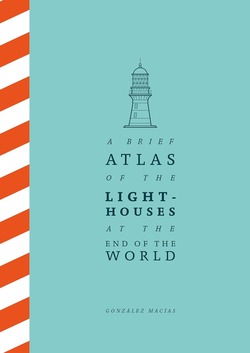In an epigraph, referring to Jules Verne’s posthumous novel, The Lighthouse at the End of the World (1905), González Macías tells how Verne never set foot in Argentina, where the novel was set, but captured that world imaginatively. Macías a self-confessed “landlubber” therefore likens himself to Verne as the only sea he has travelled in is one of information, where his fact fishing has resulted in A Brief Atlas of the Lighthouses at the End of the World (2020, tr: Daniel Hahn, 2023).
Macías takes us on an alphabetical journey around the world in thirty-four lighthouses, typically offering up four pages for each. The first page names the tower and, in its prose, offers up historical accounts, personalities, lore, and significant events. Opposite this is the author’s illustration, a somewhat pointillist representation of the lighthouse in subdued blues. Then we get an architectural drawing, with that page offering up the sort of stats that would make a lighthouse top trumps game fun (age, height, focal length, etc), and a nice touch is to see the page’s edge marked with scale of sea level and focal plane of light. Finally, an atlas zones in on its location, showing how remote the light truly is.
In a way, the book is a spiritual successor to Judith Schalansky’s Atlas of Remote Islands: Fifty Islands I Have Not Visited and Never Will (2009, tr: Christine Lo, 2010), in content, format, and focus on places so off the beaten track we need books like this to inform us of their very existence. I’d say that Macías is more interested in presenting his findings about his subjects as interesting tidbits with a descriptive sensibility, whereas Schalansky’ book whips her entries into shape as prose-poems.
The first lighthouse Macías visits is Adziogol in Kherson and it’s such a beautiful and unique structure, like a wicker basket, that my first instinct was to check on its welfare given current events in Ukraine. (Three missiles hit it in July, 2022, but still standing, thankfully.) But while all structures persist, their activity doesn’t. Guardafui in Somalia stands in ruin, a stunning stone colossus that serves as a reminder of Italy’s fascist past.
The stories in the book run the gamut, from tales of female derring-do, (Ida Lewis at Lime Rock, Rhode Island; Grace Darling at Longstone, Northumberland) to ghost stories and famous disappearances; from sunken ships to political prisoners; from extinctions to literary inspiration, notably Virginia Woolf’s To The Lighthouse (1927) and Edgar Allan Poe’s incomplete and untitled final text.
Although the rise of technology has all but killed the need for lighthouse-keepers (and indeed, for lighthouses), there are still the stories of those that served within them, and where interesting, Macías gives them their due. Loneliness, madness, and death season their tales. As time goes on there will be fewer stories to tell, and so it’s for books like this to preserve them. It’s as if the “romantic guardianship” that the lights once offered must now be guarded, just as romantically, in the books written about them.
